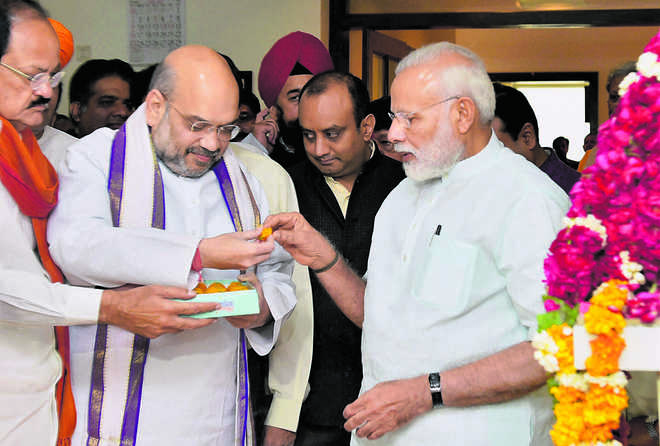
Hands full: Hype and theatre may prove costly both at home and abroad.
KC Singh
THE Modi government’s three years in power are being debated on television and in newspaper columns. PM Modi’s personal high popularity, particularly post-Uttar Pradesh election sweep, remains the BJP’s talisman, be it elections to state Assemblies or municipalities. This reflects the classic weakness of the Westminster form of government that dominant prime ministers, who win elections and thus have captive parties, have all powers of a US president without the check of the US Congress and the Supreme Court. Examples abound — Indira Gandhi, Margaret Thatcher, Golda Meir, Pierre Trudeau, etc.
India wanted a strong prime minister and got one. But the centralisation of power has its perils. The agenda of governance has mutated over the last three years without debate or explanation but for electoral benefits. Foreign policy contrariwise has been sluggish as the external environment has altered drastically in the last six months. Both need examination.
Domestically, the economic agenda has veered from comprehensive reform to episodic moves like demonetisation and GST. Gains from the former are still illusory. In case of GST, multiple duty structures are leading to massive lobbying by industry to get into lower rate groupings. The actual implementation will be less smooth than anticipated. Instead of overhauling the tax regime and reforming the revenue department, the taxman has been empowered and is being used to target political opponents. A technology-based regime of intrusive scrutiny and fear is the government’s method for tax compliance and higher revenue.
Rather than ‘Sabka saath sabka vikas’, social disharmony is rampant in BJP-ruled states due to lax control of vigilantes and subtle targeting of minorities. The resulting birth in UP of a new Dalit outfit, the Bhim Sena, portends ill for the future. The biggest concern is the likely radicalisation of Muslim youth, something India’s enemies were unable to achieve since the Al-Qaeda’s rise in India’s neighbourhood and Pakistan’s export of terror from the 1990s.
However, the Indian foreign policy and national security today face serious dilemmas. Modi inherited the foreign policy tweaked for the post-Cold War world by then PM Narasimha Rao. Vajpayee and Manmohan Singh fine-tuned the themes, but essentially there was continuity. The approach rested on improving relations with the US, detente in the neighbourhood, ‘Look East’ outreach to ASEAN, rebalancing in West Asia by diplomatic engagement with Israel, containing/engaging Pakistan while countering radical Islam in Afghanistan, and finally with China, broadened cooperation while sidelining disputes temporarily.
Modi brought new energy and theatrical and personalised diplomacy to these themes. Diaspora engagement was crafted like popstar concerts. With Pakistan he began well, inviting all SAARC leaders for his inauguration, but soon reverted to confrontational rhetoric. His courting of Chinese President Xi Jinping did not flourish as China sought hegemony, not partnership. Modi operated on traditional strategic assumptions that the US would permanently support India as a counter-weight to rising China; Pakistan would weaken and be more isolated as the US support declined post-US troop withdrawal from Afghanistan; China would push, but not openly confront India as its Indian market access increased and lopsidedly high balance of trade persisted; SAARC countries would remain neutral or tilting towards India in this Indo-Sino-Pak elbowing for strategic space; and finally the Islamic world would ignore the Hindutva agenda that reaped electoral benefits by selective baiting of minorities via issues like cow slaughter and triple talaq.
These assumptions today stand undermined. President Donald Trump, after some China-baiting, used Henry Kissinger as a go-between to craft a deal whereby the Chinese will provide greater market access and invest in the US in exchange for perhaps the lowering of US opposition to their regional ambitions. Trump had already withdrawn from the Trans-Pacific Partnership (TPP) and the new China outreach will fragment ASEAN further as individual nations run for the exits to cut deals with China. Meanwhile, India finds itself confronting China over their belt and road initiative, the CPEC part of which transgresses Indian claims to Gilgit-Baltistan. The Pakistan-China alliance is manifest in Beijing’s announcement that the Chinese stand on Indian membership of NSG remains negative.
Meanwhile, Pakistan was amidst the Sunni potentates gathered by Saudi Arabia for Trump soiree on May 19-21, where he sought the purging of radical Islam from their body polities. He then berated Iran’s missile programme and support to terror. Iranian foreign minister Javed Zarif tweeted: ‘Iran-fresh from real elections-attacked by @POTUS in that bastion of democracy and moderation. Foreign policy or milking KSA of $480B’. Pakistan’s former army chief heads the military alliance. Pakistan was serenaded in Beijing, where the Chinese topped the earlier CPEC commitments with more goodies. This is hardly an isolated Pakistan. The sheer brazenness of sentencing Kulbhushan Jadhav to death in a summary trial is indicative of new confidence, sensing China fully in their corner.
Nascent structures for a new Asian security order are built around ASEAN — ASEAN Regional Forum (ARF) and East Asia Summit (EAS). Therefore if ASEAN gets divided, China can push new Sino-centric structures. The sinews of the new spoke and wheel paradigm, centred on China, would be the belt and road initiative. Notably, India’s SAARC neighbours are hurrying to join it.
Thus three years into his term, PM Modi requires a fresh counter-strategy to face the new scenario. He has Iran now, and perhaps Russia, to some extent, to work with as he meets a transactional Trump, an opportunistic neighbourhood, an aggressive China and a resurgent Pakistan. Two years remain for course correction, failing which hype and theatre will prove costly at home and abroad.
The writer is a former Secretary, Ministry of External Affairs



























